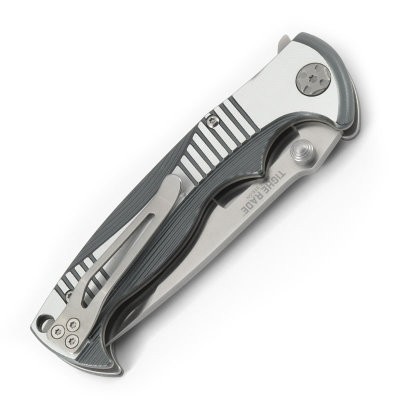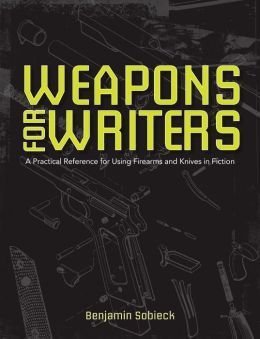Benjamin Sobieck's Blog, page 17
February 12, 2015
Re-Thinking Knives as Functional Art
Since I had the bug to fiddle around with customizing knives last week, here's a look at the one we commissioned at BLADE, the knife magazine I work for.
We do one of these every year to mark the BLADE Show each June in Atlanta. It's the world's premier knife show, in my totally biased opinion (BLADE owns the show). Knife makers and collectors fly in from all over the world to buy and sell knives. And I don't mean the junky knockoffs you can pick up at a gas station. I'm talking about functional art, with some knives fetching as much as $100,000 or more.
Our commemorative CRKT Tighe Rade is just a hair south of those figures, available exclusively at ShopBlade.com for $50. It's something fun for knife collectors, and it's always a treat to watch these blade babies sell out fast.
Thinking of knives as commemoratives brings me back to getting married, oddly enough. I gave each of my groomsmen a Kershaw Leek (maybe that's why that knife made it into Weapons for Writers).
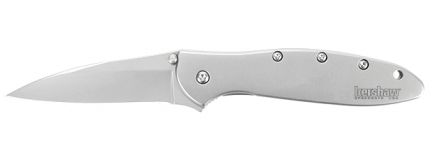
None of that Things Remembered mall knife stuff for me, thank you very much. I wanted to give them the real deal. That it was an assisted opening knife probably scared the hell out of them the first time the blade popped open. But maybe that's what I was going for in the first place.
At some point in my life, I'd like to commission a true custom knife. One made from scrap metal and whatever gets swept up in the garage, then forged into something unique. I've been bit by that bug for a long while now. It's probably why I gave the protagonist in the novel I'm working on a knife made from a lawnmower blade.
The point here is that knives can be a lot more than sharp things waiting to cause an injury. They can rise above mere tools and become something more meaningful. If I have any regrets about Weapons for Writers, it's that I didn't pursue that point. Honestly, there wasn't space for anything but practical information.
I hope in the process of explaining a bit about knives, readers are able to pick up on my intentions. I don't want anyone to read Weapons for Writers for tips on using knives to murder people. I want them to start seeing the features that make knives art. The way the blade flows into the handle. The contours of the steel. The detailed patterns. The balance in the hand. The history. The "spirit" of the knife, as it's called, that communicates through the design. And above all, the knowledge that all of this started as a formless piece of metal until the right person came along to work it into something more.
Just something chew on. I'll leave you with some more pics that demonstrate what I mean. Each was made by hand. These are from Best Custom Knives, a digital book published by BLADE.
[image error]
[image error]
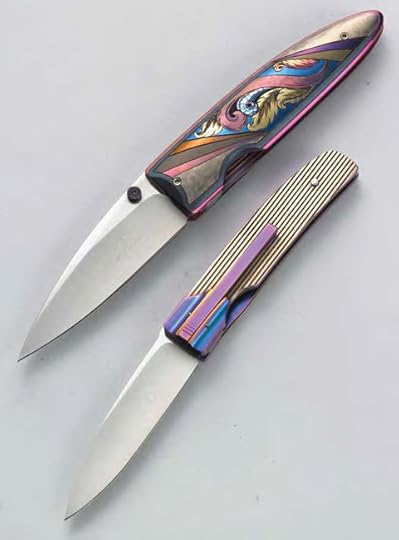
[image error]
* This last one is made from solid gold. Believe it.
Be sure to sign up for my free e-newsletter, packed with exclusives you won't find here. Pre-order Weapons for Writers here from Amazon.
February 6, 2015
Dramatic Pumping: Just Say No, ExLax
Writerfolk, whenever you get the itch to write in a character dramatically pumping a shotgun in a story, stop. Come up with a different method of intimidation. I know you've seen it countless times in movies and TV shows, but as @abnersenires so eloquently stated on Twitter, it's the wrong kind of smooth move.
@benjaminsobieck Ah, yes. Dramatically pump loaded shotgun with one in chamber, lose a round. Smooth move, ExLax. :P
— Abner Senires (@abnersenires) February 6, 2015
Giving Knife Designing a Try
I don't know if anything will come of this, but I'm experimenting with some designs over at the Benchmade custom knife creator. I'm thinking I'll give away a knife as part of the launch for Weapons for Writers this summer. Here's my first stab at a design. The title is on one side. A handwriting pattern is on the other.
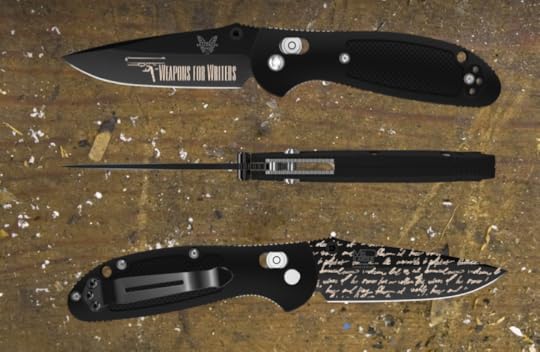
[image error]
I like this version with the two handle colors, too.
[image error]
February 5, 2015
Ammunition for Shooting Down Drones?
Here you go, writerfolk. It's ammunition specifically designed to shoot down drones. All I know about this product is from this press release. Note the "ferromagnetic ballistic payload," which I presume to be some sort of explosive.
[image error]
February 4, 2015
Explosive News - New Pulp Press to Publish THE INVISIBLE HAND

It’s been quite the ride for The Invisible Hand, my crime novel set in the North Dakota oil boom, but I finally have some good news. I just dropped a publishing contract with New Pulp Press into the mail. The Invisible Hand should release some time in late 2015, although that’s not set in stone.
New Pulp Press is an incredible indie outfit publishing some of the best crime fiction today. Hell, it even publishes Les Edgerton’s The Bitch, one of my all-time favorite novels, among others. For me, it's a best-case scenario.
I feel excited, and more than a little vindicated, about this development. Last November, I participated in the pilot program of Kindle Scout. Despite a fat dose of press about that campaign (I get more e-mails about it than anything else I’ve done), I did not win a contract with Amazon’s new Kindle Press. It’s not even that Amazon was my first choice. It wasn’t. It’s that I thought this novel had legs, and I needed to find the right people who could see the same. And it turned out that wasn’t the casual readership of Kindle Scout.
No, it was the crew at New Pulp Press. They’re more in tune with this style of batshit crazy story. If there’s a lesson in that, it’s that, writers, whether something is a success or a failure often depends on whether you’ve reached the right reader, not on the quality of work itself. It’s why vertical review outlets, such as Spinetingler or CrimeSpree, are going to “get” a piece of crime fiction better than the horizontal Wild West of Goodreads.
For only being a month into 2015, this is shaping up to be one hell of a year. My Writer’s Digest book on guns and knives, Weapons for Writers, drops in late June/early July. The Invisible Hand may well come soon after that, but we'll see. And I’m almost finished with my next novel about a fraudulent psychic called in to find a missing girl. Hot damn.
Shits and giggles,
Ben
pic via sxc.hu
January 23, 2015
How NOT to Handle Guns in a Scene
Watch the revolver in this clip from Ed Wood's cheese fest, Plan Nine from Outer Space. Can you count the number of times the detective aims it at himself and the other officers? Your characters would do best to only aim a firearm at people and objects they're willing to shoot. And they'd never look down the barrel of a gun to see if it's loaded.
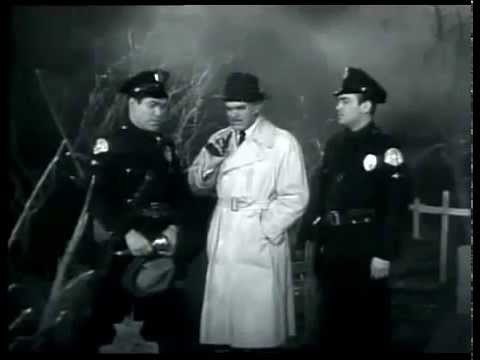
January 8, 2015
David Morrell to Write Foreword to Writer's Digest Book
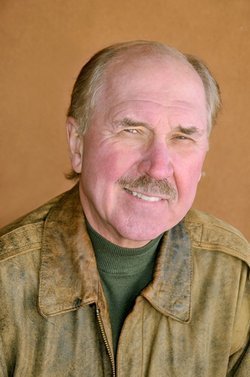 I can now make it official: David Morrell, the author of First Blood and creator of Rambo, will be writing the foreword to my Writer’s Digest book, Weapons for Writers: A Practical Reference for Using Firearms and Knives in Fiction.
I can now make it official: David Morrell, the author of First Blood and creator of Rambo, will be writing the foreword to my Writer’s Digest book, Weapons for Writers: A Practical Reference for Using Firearms and Knives in Fiction.
I’m beyond thrilled about this development. Morrell’s John Rambo character looms large over pop culture. A fifth (fifth!) Rambo movie, Last Blood, was even announced earlier this month, with Sylvester Stallone reprising his famous role. The portrayal of firearms and knives in those movies influenced countless writers, sometimes in good ways (familiarization with certain models and types) and other times not so much (unrealistic portrayals of weapons). But that’s what keeps people like me in business. It’s safe to say that without Morrell’s Rambo, Weapons for Writers wouldn’t be what it is today (or will be when it hits in July). Hell, it might not even exist at all.
Which is why Writer’s Digest hit it on the head by tapping Morrell for the foreword. Damn.
Of course, Morrell is known for much more than just Rambo. Here’s his extensive biography from Amazon.
David Morrell is the author of FIRST BLOOD, the award-winning novel in which Rambo was created. He holds a Ph. D. in American literature from Penn State and was a professor in the English department at the University of Iowa. His numerous New York Times bestsellers include the classic spy trilogy that begins with THE BROTHERHOOD OF THE ROSE, the basis for the only television mini-series to premier after a Super Bowl. The other books in the trilogy are THE FRATERNITY OF THE STONE and THE LEAGUE OF NIGHT AND FOG. An Edgar, Anthony, and Macavity nominee, Morrell is the recipient of three Bram Stoker awards and the prestigious Thriller Master award from the International Thriller Writers organization. His writing book, THE SUCCESSFUL NOVELIST, discusses what he has learned in his four decades as an author. His latest novel is the highly praised Victorian mystery/thriller, MURDER AS A FINE ART.
Yeah, like I said. Damn. Rare is Morrell’s breed. Be sure to pick up First Blood if you haven't already, along with the rest of Morrell's catalog.
I know it’s a weekday and all, but, please, enjoy an adult beverage when you get home. Toast to this great news and celebrate with me.
Best,
Ben
* Author photo via Amazon
January 6, 2015
On Writing Guns - How to Load Submachine and Machine Guns
Dear Ben,
As an Australian writer working on his first novel, I need information from time to time on the step-by-step procedures involved in loading, cocking, aiming and shooting certain firearms, such as when to flick off the safety lever, and so on.
Is there a writer’s guide available in hard copy that will tell me, step by step, how to prepare to shoot most rifles, shotguns, sub-machine guns and handguns – including notable exceptions to the rule so I don’t make a mistake in my book? This would be very handy in my line of work.
In the meantime, can you tell me, please, how to prepare an L1A1 self-loading rifle (SLR) and an Uzi sub-machine gun for firing?
Regards,
Peter Greer
Queensland, Australia
***
First off, congratulations on taking the big step with that first novel. Exciting times.
In response to your first question, yes, there is such a book. And as a matter of fact, I wrote it. It’s called Weapons for Writers: A Practical Reference for Writing Firearms and Knives in Fiction. It drops in July 2015, available for pre-order here.
With the shameless plugging out of the way, this would be a good time to do a brief overview of how most submachine and machine guns are loaded. It’s not too difficult, but a lot of writers likely don’t have experience in this area.
How to Load and Fire a Submachine or Machine Gun (the quick version)
1) Character inserts a magazine of ammunition into the firearm's magazine port (could also call this the receiver).
2) Character racks the charging handle (also called a cocking handle). "Racking" means the character pulls back on this handle, then releases it. This action moves one cartridge (aka shell or round) from the magazine into the chamber, which is the spot inside the firearm where a cartridge is seated to be fired.
3) Character moves a selector switch from safe into a semi-automatic, burst or fully automatic mode (depending on the model).
4) Character pulls the trigger.
5) Character unwinds after the gun battle with a beer and the Packers game on TV. (optional)
That’s a rough outline of how submachine and machine guns work. Things change when the models are more specific. That requires a little research, because certain terms and parts are specific to gun models. Here are the steps tweaked for the Uzi and L1A1.
How to Load and Fire an Uzi
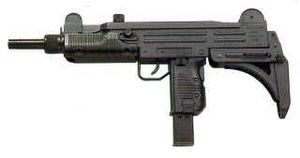
* Wikipedia image
1) Character inserts a magazine of ammunition into the firearm's magazine port (could also call this the receiver).
2) Character racks the charging handle (also known as a cocking handle), which is a sliding knob on the top of the firearm.
3) Character moves a selector switch from safe into a semi-automatic or fully automatic mode. The selector switch has three modes: safe (gun can't shoot), semi-automatic (one pull of the trigger equals one shot fired) and fully automatic (firearm will shoot so long as the trigger is pulled).
4) Character pulls the trigger.
How to Load and Fire an L1A1 (aka FAL and a bunch of other names)

* Wikipedia image
Just a note that in the States we'd call this gun a FAL. Not sure if that means anything to your novel, but it goes by a number of names depending on the country it's being used in (and it's been used in almost every Western country since the Cold War at some point). If you know it as the L1A1, then roll with that.
Also, the L1A1 only comes in a semi-automatic version. If your novel needs it to have a fully automatic mode, write in the L2A1.
1) Character inserts a magazine of ammunition into the magazine port (could also call this a receiver).
2) Character racks the charging handle, usually located on the left side of the firearm.
3) Character toggles a safety lever from safe to fire mode (if it's the L2A1, this switch would toggle between safe, semi-auto and full-auto modes).
4) Character pulls the trigger.
Good luck with your novel, Peter!
Best,
Ben
P.S. If you enjoyed this article, please sign up for my free e-newsletter. It's packed with even more tips on writing guns and knives that I don't post anywhere else.
P.P.S. If you have a question about guns or knives for your writing projects, feel free to drop me a line at Ben [dot] Sobieck [at] gmail [dot] com. The only catch is that I'll post replies here.
P.P.S. What's the difference between a submachine gun and a machine gun? It's all in the ammo. Submachine guns use handgun ammunition. Machine guns use rifle ammunition. This usually, but not always, means a submachine gun is smaller than a machine gun. However, they're both capable of fully automatic operation. They'll fire so long as the trigger is pulled.
December 17, 2014
Noir at the Bar - Roseville, MN - January 22, 2015
This looks like fun.
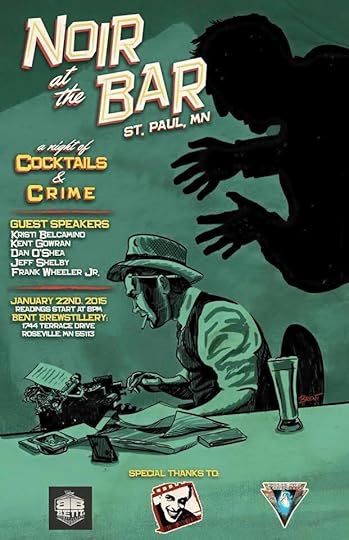
December 13, 2014
Interview - 12 Rounds with Les Edgerton
Les Edgerton is one of the most capable crime writers alive, which should come as no surprise to anyone familiar with his background. Edgerton makes no bones about his criminal history, which eventually landed him a stint in prison. That kind of frankness makes him one of the best interviewees around.
Edgerton’s latest novel, The Genuine, Imitation, Plastic Kidnapping, made my shortlist of the best reads of 2014. At the end of the novel, Edgerton leaves the reader with personal notes outlining the true-to-life events that inspired the novel. I couldn’t resist picking his brain.
***
Q: I look at KIDNAPPING as THE BITCH 2.0 in that the cons and humor in the latter are amplified in the former. Did you write KIDNAPPING with THE BITCH in mind?
A. Not at all. Actually, I wrote KIDNAPPING many years before I did THE BITCH. If there are similarities, it’s only because my mind and world-view works fairly consistently.
Q: Your notes at the end of the novel say that KIDNAPPING is your way of getting back to writing "simply to entertain and get a laugh from readers." What were you burnt out on that you needed to get back to that?
A. Just unrelenting seriousness in the last few books I published. Just thought it was time for a few chuckles. It’s the original reason I began writing as a tyke in short pants—to entertain. Well, and to score chicks, but that doesn’t always work out the way you hope it does.
Q: You wrote a screenplay version of KIDNAPPING. What's the status on that?
A. Same as ever, I guess. Just hoping someone asks to see it. It’s listed on InkTip and that’s about it. I get looks at the logline and sometimes at the script, but so far nothing much has happened. That’s my fault, I know. It’s just too energy-draining to keep trying to market things and I’d rather spend the time writing. Hollywood’s a young person’s game, totally. Over the age of about 35, it’s pretty well over as far as pitching stuff yourself. It’s really a matter of somehow getting the right person to read it.
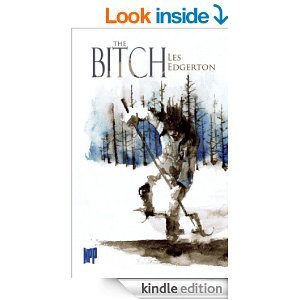 And, the “right person” means an A-List actor or director who sees it as something that can help their career. I keep thinking that there are a few folks out there who if they ever got to read it would be interested. People like Woody Harrelson and the guy who plays Charlie on “It’s Always Sunny in Philadelphia” would be the perfect pair as Pete and Tommy, for instance. If anyone knows them I’d love to get the script into their mitts. I don’t know who I see playing Cat—she’s honestly better looking and sexier than any actress I can think of off the top of my head. But, I think whoever played her would find it a star-making role.
And, the “right person” means an A-List actor or director who sees it as something that can help their career. I keep thinking that there are a few folks out there who if they ever got to read it would be interested. People like Woody Harrelson and the guy who plays Charlie on “It’s Always Sunny in Philadelphia” would be the perfect pair as Pete and Tommy, for instance. If anyone knows them I’d love to get the script into their mitts. I don’t know who I see playing Cat—she’s honestly better looking and sexier than any actress I can think of off the top of my head. But, I think whoever played her would find it a star-making role.
Q: You confess to taking part in prostitution in the novel's notes. Not as a john or pimp, but as a passive participant of the "services rendered." Any concerns about sticking that into the public eye?
Nah. I’m no longer a minister, so what would I lose? Come to think of it, I’ve never been a minister so I don’t know what harm it does to have folks know. I thought it was kind of cool at the time—I mean, who gets to cut coke lines, drink top-drawer booze, in a world-class hotel, watch a couple of world-class call girls work out and get paid for it as well as taken out and treated to a fantastic meal at Gallatoire’s? Kind of the dream gig, in my opinion. I was also an escort for a long time for a top New Orleans escort agency where I was the companion for older, wealthy women, and trust me, that beats working on the boot line at the Goodyear plant.
Q: A character in the novel, Robert, enjoys the company of prostitutes in heels stomping on his body while a man hurls insults at him. In the notes, you say Robert is a real-life celebrity and that you participated in some of this. Can you give me a tiny hint about the who the celebrity might be? If you don't tell me, I'm assuming Emeril Lagasse. It's Emeril, right? Please say yes.
Nope. Much bigger. I’m probably going to get in major trouble here, but this guy was one of the biggest politicians in New Orleans and his kid is a world-class jazz singer. Every time I see him on the Tonight Show, I think: “I know some shit about your old man, kid.” I think I’ve said too much already.
Q: The character of Cat is also based on a real person. You even used her real name. From your notes at the end of the novel, the character doesn't sound half as nuts as the real-life version you described. Any worries about that coming back to bite you?
A. Hopefully. I miss her! I’d love for her to show up and take another shot at me—are you kidding? That was fun! She was without a doubt the most exciting person I’ve ever known. She was much, much bigger than any fictional character. Her mother sold her to Carlos Marcellus when she was 8 or 9 for a bag of weed (Mom was a junkie) and then Cat made the career-ending mistake of turning 12—way too old for this “Romeo” and he turned her out. She went down to the Quarters and survived by prostituting, rolling sailors, dealing drugs, etc.—anything to survive—and I met her when she was 25 and a top call girl.
We had a lot of chuckles together. She tried to kill me a bunch of times and it was just plain exciting. That sounds probably worse than it was---each time, it was on the spur of the moment and she was over it quickly and we went on as per usual. I loved living on the edge with her. She’s probably dead by now—can’t imagine her still alive, although it’s possible, I guess. But, she doesn’t read much, so she’ll probably never read the book.
If it gets made into a movie, chances are better she’ll see it. She’s in my memoir, ADRENALINE JUNKIE, extensively, and if it ever gets published she might find out about that. HBO Films wanted it a few years ago and were all ready to film it but the book deal fell through or it would have been out. The prez of HBO read it and said it was “…a PERMANENT MIDNIGHT, but with balls.” I think that’s high praise, but then I never thought Jerry Stahl’s story was that big of a deal. If I’d grown up in suburbia and had an allowance and lawns to mow when I was a kid, I might have, but his deal seems mostly kind of “poor rich kid falls down and skins his knee” kind of hi-jinks. He spirals into the cocaine abyss because he was too smart to be writing ALF? Cut me a break.
By the way, I wouldn’t call Cat nuts at all. She always acted within the perfect logic of her personal experience. If she hadn’t been a little “nuts” she probably would have been killed years ago.
Q: Like your other novels, this one is based on your past experiences, and you make that known in your notes at the end of KIDNAPPING. Given those experiences landed you in prison, were they worth it for the sake of writing books later on? Would you change anything?
A. Nope. Not a thing. It was all great material. Actually, I knew I was going to prison a long time before I got there. It takes cops forever to catch someone if they don’t want to cooperate, but I knew I end up there and it didn’t bother me at all. Now, after having been there, I wouldn’t have been so anxious to arrive, but even so, it was all worth it. You can’t buy the kinds of experiences I’ve had—they’re priceless. As for the price of writing books, whatever that is—Faulkner got it exactly right when he said: “The Ode On a Grecian Urn is worth any number of old ladies.” Perfectly said.

Image via Les Edgerton's Amazon author page
Q: Does it ever rub you the wrong way to see other crime writers try to play up a tough guy image without having actually lived it the way you have?
A. It used to, but not really. I just don’t buy many of them as having much experience along those lines and it shows. It seems like it’s always a kind of a shuck—that they’re just trying to sell wolf tickets and anyone who understands “Jeff Chandlerin’” (a term we used to use) knows these guys are harmless and fold pretty easily. When I see so-called fictional “outlaws” hanging out in strip clubs and having all these choreographed fights it’s just funny. No actual outlaw hangs out in strip clubs—those are mostly for losers and wannabes—and I don’t know anyone who fights like John Wayne in real life and lives very long. I really don’t ever want to hang with someone who thinks strip clubs are cool or are some kind of outlaw milieu.
I was lucky. I was an outlaw when outlaws were really outlaws. Now they all seem to be meth users and druggies and those were creeps in my day. I’d be ashamed if I had to get drunk or high to rob a place—seems kind of sissified and punkish. We didn’t have all these gangs in my day either—no secret handshakes and all that crap. Most jobs I did on my own and the only ones I ever had trouble on were done with others who got caught and then rolled over on me. Pull your own crimes and the odds of getting caught are greatly diminished. Some folks don’t have the balls to do that, though.
There are so many untrue myths about criminals. That you can’t make a living and will always get caught. The amateurs do. The druggies do, I guess. I still know guys who’ve been robbing places all their lives and haven’t even sniffed a bust. It’s the same crap about gamblers. I made my entire living as a gambler for four years and never lost money. I’ve done things that are still open under the statute of limitations I can never write about but know how to do things and get away with them. I didn’t quit pulling crimes because I had some kind of come to Jesus moment—I just plain don’t like the food in the joint or the restriction of movement. It’s a lot better on the bricks.
Recently, I had this hoary old agent contact me after he read my story in the Springsteen anthology and thought I had some “ability” and wanted me to send him some stuff. On a lark, I did, especially when I found out he used to rep a former criminal we are all aware of. It got weird when he asked what I was writing currently and I told him it was about a hitman who made all his hits look like accidents and this dude wrote back and said that would be impossible—that such a hitman hadn’t existed after 1977 (still don’t know where he got that), and I sent him a clipping about a friend of mine—Kenny Vincent, the nephew of Marcellus who is an old friend of mine—who has “acquaintances” who do exactly that today. This old fart made the mistake a lot of people do—if it isn’t in their life experience they don’t believe it can happen. Another “expert” who, as it turns out, is mostly impressed by his own, limited experience. That turned out to be the end of our correspondence—he didn’t want to be challenged, I guess.
Q: The "N word" comes up a few times in KIDNAPPING. You mention in the notes that a screenwriter you worked with, a black man, thought its use was appropriate given the context. Why'd you feel this was important to highlight to readers?
A. Good question! And, I’m ashamed to say that I was probably covering my butt. Me, who hates being PC! We all have our weak moments, don’t we? Actually, I don’t care if anyone was insulted, but my black friend assured me that there was nothing racist in it so… And, why do we say “the N Word,” when it’s all right to say “honkey?” It stands for “nigger” and that’s a perfectly good word. Mark Twain used it and he’s probably our best writer. It’s just a frickin’ word. Where’s George Carlin when you need him?
Our language is getting horrible. It’s like the terms “invited guest” and “home invader.” That seems to be the same difference as legal immigrant and illegal alien. Logic in language seems to have fled the culture…
Q: The message underneath the comedy in KIDNAPPING, at least from my point of view, is that what's important to a person depends not on the who or the what, but the how. Perception is reality, and if you can manipulate how something is perceived, you can change its importance to a person or a group of people. Is that what you were going for or am I totally off? If it is, are you suggesting that most of day-to-day existence is the result of people conning each other, both legally and illegally?
A. Great question! And, of course the answer is yes—there’s probably not a human exchange in any day of the year in which both parties are completely honest and without an agenda. It’s what being a human is. We’re all involved in a shuck with each other. We all want something from the other person. The trick is to want something they want to give up. And, that’s just about everything. It’s an ongoing negotiation and game, all the time. It’s what we are. It’s why we constantly go around proclaiming we’re honest to each other. None of us are. Outlaws are the most honest and preachers are the least honest. Whenever a guy tells me he’s a Christian and shakes my hand, I always count my fingers afterward.
Q: You recently had a bout of COPD that you said on your blog could have been, "the big one." Given how close to the razor's edge you've lived, does this bother you? In other words, of all the ways it seems you could've bought it, does going out with COPD seem inappropriate?
A. Yeah. My dream has always been to get shot by a jealous husband when I was 99 and climbing out a bedroom window. COPD just seems so fucking inadequate.
Q: What's the last movie you watched?
A. Can’t remember in a theater. Haven’t been to a theater in probably 20-30 years. I think it might have been CITIZEN KANE. The key word is “Rosebud” in case anyone hasn’t seen it… Last movie I watched at home was one of my favorites, NATURAL BORN KILLERS. Woody definitely knows how to play a bona fide outlaw. He’s a guy I’d love to have beers with but I’d make sure I was sitting with my back to a wall and had a weapon handy. Oh, and I just watched ONCE WERE WARRIORS which is one of my all-time favorites.
If you enjoyed reading this interview, sign up for my free e-newsletter here.


